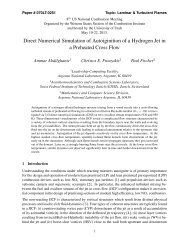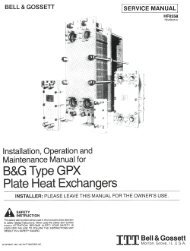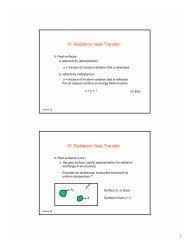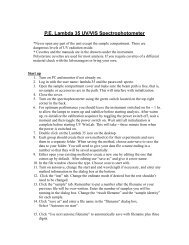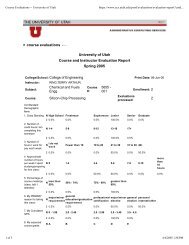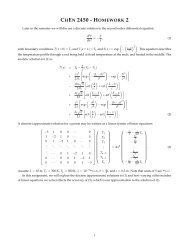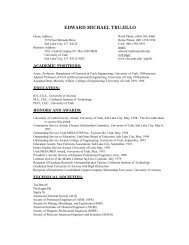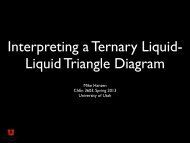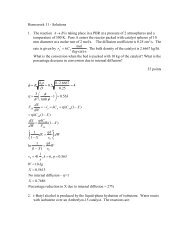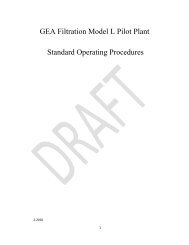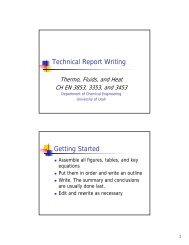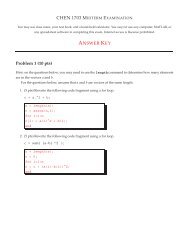Instructions for HACH Free and Total Chlorine Analysis
Instructions for HACH Free and Total Chlorine Analysis
Instructions for HACH Free and Total Chlorine Analysis
You also want an ePaper? Increase the reach of your titles
YUMPU automatically turns print PDFs into web optimized ePapers that Google loves.
<strong>Chlorine</strong>, <strong>Free</strong> <strong>and</strong> <strong>Total</strong>, TNTplus, 10231 <strong>and</strong> 10232<br />
<strong>Chlorine</strong>, <strong>Free</strong> <strong>and</strong> <strong>Total</strong> TNTplus<br />
DOC316.53.01248<br />
DPD Method 1<br />
<strong>Free</strong> <strong>Chlorine</strong>: Method 10231<br />
(0.05 to 2.00 mg/L Cl 2 ) <strong>Total</strong> <strong>Chlorine</strong>: Method 10232<br />
Scope <strong>and</strong> Application: For drinking water, wastewater <strong>and</strong> pool water. TNTplus 866/866T<br />
1 Adapted from St<strong>and</strong>ard Methods <strong>for</strong> the Examination of Water <strong>and</strong> Wastewater.<br />
Test preparation<br />
How to use instrument-specific in<strong>for</strong>mation<br />
The Instrument-specific in<strong>for</strong>mation table displays requirements that may vary between<br />
instruments. To use this table, select an instrument then read across to find the corresponding<br />
in<strong>for</strong>mation required to per<strong>for</strong>m this test.<br />
Table 1 Instrument-specific in<strong>for</strong>mation<br />
Instrument Light shield Adapter<br />
DR 5000 — —<br />
DR 2800 LZV646 —<br />
Be<strong>for</strong>e starting the test:<br />
DR 2800: Install the light shield in Cell Compartment #2.<br />
Read the safety in<strong>for</strong>mation <strong>and</strong> expiration date on the package label.<br />
Analyze samples immediately. Do not preserve samples <strong>for</strong> later analysis.<br />
Color or turbidity in the sample can cause incorrect results. To correct <strong>for</strong> color or turbidity, measure a Sample blank.<br />
Per<strong>for</strong>m this test at 15–25 °C (59–77 °F) <strong>and</strong> store reagents at 2–8 °C (35–46 °F) <strong>for</strong> best results.<br />
The recommended sample pH is 3–10.<br />
To sequentially measure free <strong>and</strong> total chlorine, measure free chlorine <strong>and</strong> then complete steps 2–4 <strong>and</strong> 6 of the total<br />
chlorine procedure.<br />
Potassium iodide Solution A <strong>for</strong> total chlorine is included with the TNT866T reagent set but is not packaged inside the box.<br />
A Zero vial is included in the TNT866 reagent set. The same vial is used to zero the instrument <strong>for</strong> the entire lot of reagents.<br />
TNTplus methods are activated from the Main Menu when a vial is inserted into the sample cell holder.<br />
Collect the following items:<br />
Description<br />
Quantity<br />
Light Shield (see Instrument-specific in<strong>for</strong>mation) 1<br />
<strong>Chlorine</strong> TNT866 Reagent Set 1<br />
Potassium iodide Solution A (<strong>for</strong> total chlorine only) 1<br />
Beaker, 50 mL 1<br />
Disposable wipes 1<br />
See Consumables <strong>and</strong> replacement items <strong>for</strong> reorder in<strong>for</strong>mation.<br />
<strong>Chlorine</strong>, <strong>Free</strong> <strong>and</strong> <strong>Total</strong> TNTplus<br />
Page 1 of 6
<strong>Chlorine</strong>, <strong>Free</strong> <strong>and</strong> <strong>Total</strong> TNTplus<br />
<strong>Free</strong> <strong>Chlorine</strong> TNTplus method<br />
1. Insert the Zero vial<br />
into the sample cell holder.<br />
The instrument reads the<br />
barcode, then selects the<br />
method <strong>and</strong> sets the<br />
instrument to zero. The<br />
instrument shows L1 when<br />
zeroing is complete.<br />
2. Fill the sample vial<br />
with sample to the neck of<br />
the vial.<br />
3. Cap the vial <strong>and</strong><br />
carefully invert it 2 or 3<br />
times while rotating to<br />
remove any air bubbles<br />
from the sides of the vial.<br />
Do not shake.<br />
4. Within one minute of<br />
adding the sample, wipe<br />
the sample vial <strong>and</strong> insert<br />
it into the cell holder.<br />
Results are in mg/L Cl 2 .<br />
<strong>Total</strong> <strong>Chlorine</strong> TNTplus method<br />
1. Fill the sample vial<br />
with sample to the neck of<br />
the vial.<br />
2. Immediately add 3<br />
drops of potassium iodide<br />
Solution A.<br />
3. Cap the vial <strong>and</strong><br />
carefully invert it 2 or 3<br />
times while rotating to<br />
remove any air bubbles<br />
from the sides of the vial.<br />
Do not shake.<br />
4. Wait 3 minutes.<br />
<strong>Chlorine</strong>, <strong>Free</strong> <strong>and</strong> <strong>Total</strong> TNTplus<br />
Page 2 of 6
<strong>Chlorine</strong>, <strong>Free</strong> <strong>and</strong> <strong>Total</strong> TNTplus<br />
<strong>Total</strong> <strong>Chlorine</strong> TNTplus method (continued)<br />
5. Insert the Zero vial<br />
into the sample cell holder.<br />
The instrument reads the<br />
barcode, then selects the<br />
method <strong>and</strong> sets the<br />
instrument to zero. The<br />
instrument shows L1 when<br />
zeroing is complete.<br />
6. After the timer expires,<br />
wipe the sample vial <strong>and</strong><br />
insert it into the cell holder.<br />
Results are in mg/L Cl 2 .<br />
Interferences<br />
Table 2 Interfering substances <strong>and</strong> levels<br />
Interfering substance<br />
Color<br />
Interference levels <strong>and</strong> treatments<br />
Can cause high results. To make a correction <strong>for</strong> the interference, measure a Sample blank.<br />
All oxidizing agents, e.g. ozone, iodine, chlorine dioxide, manganese dioxide <strong>and</strong> chromate<br />
react with the indicator <strong>and</strong> are included in the results.<br />
Oxidizing agents<br />
If a large excess of oxidizing agents is present, some or all of the indicator changes to a<br />
colorless <strong>for</strong>m. The test result will appear to be negative or within the range of the test.<br />
pH The sample pH should be between pH 3 <strong>and</strong> pH 10.<br />
Turbidity<br />
Can cause high results. To make a correction <strong>for</strong> the interference, measure a Sample blank.<br />
Sample blank<br />
If the sample has color or turbidity, measure a sample blank to correct the test result <strong>for</strong> the<br />
interference.<br />
Required:<br />
• TNTplus 919 sample blank vial<br />
Procedure<br />
1. Complete the test procedure <strong>for</strong> free or total chlorine.<br />
2. Fill a TNTplus 919 sample blank vial with sample to the neck of the vial.<br />
3. Wipe the vial <strong>and</strong> insert it into the cell holder. The instrument will read the barcode of the<br />
sample blank vial <strong>and</strong> subtract the value from the original test result.<br />
<strong>Chlorine</strong>, <strong>Free</strong> <strong>and</strong> <strong>Total</strong> TNTplus<br />
Page 3 of 6
<strong>Chlorine</strong>, <strong>Free</strong> <strong>and</strong> <strong>Total</strong> TNTplus<br />
Sample collection, preservation <strong>and</strong> storage<br />
Accuracy check<br />
• Analyze samples <strong>for</strong> chlorine immediately after collection. <strong>Free</strong> chlorine is a strong oxidizing<br />
agent <strong>and</strong> it is unstable in natural waters. It reacts rapidly with various inorganic compounds<br />
<strong>and</strong> more slowly oxidizes organic compounds. Many factors, including reactant<br />
concentrations, sunlight, pH, temperature <strong>and</strong> salinity influence decomposition of free chlorine<br />
in water.<br />
• Avoid plastic containers since these may have a large chlorine dem<strong>and</strong>.<br />
• Pretreat glass sample containers to remove any chlorine dem<strong>and</strong> by soaking in a dilute bleach<br />
solution (1 mL commercial bleach to 1 liter of deionized water) <strong>for</strong> at least 1 hour. Rinse<br />
thoroughly with deionized or distilled water. If sample containers are rinsed thoroughly with<br />
deionized or distilled water after use, only occasional pre-treatment is necessary.<br />
• A common error in testing <strong>for</strong> chlorine is not obtaining a representative sample. If sampling<br />
from a tap, let the water flow <strong>for</strong> at least 5 minutes to ensure a representative sample. Let the<br />
container overflow with the sample several times, then cap the sample containers so there is<br />
no headspace (air) above the sample. Per<strong>for</strong>m the chlorine test immediately.<br />
To validate the method, use a st<strong>and</strong>ard solution in place of the sample. The st<strong>and</strong>ard solution must<br />
be prepared by dilution.<br />
Required <strong>for</strong> accuracy check * :<br />
• <strong>Chlorine</strong> St<strong>and</strong>ard Solution Ampule, 50–75 mg/L Cl 2 (exact concentration shown on label)<br />
• Ampule breaker<br />
• Volumetric Flask, 100-mL glass<br />
• Pipet, variable volume<br />
• Pipet tip<br />
• Deionized water<br />
St<strong>and</strong>ard solution method<br />
1. Add approximately 50 mL of deionized water into a clean 100-mL volumetric flask.<br />
2. Open a chlorine st<strong>and</strong>ard solution ampule, 50–75 mg/L Cl 2 .<br />
3. Use a pipet to add 2.0 mL of the st<strong>and</strong>ard solution into the flask.<br />
4. Dilute to the 100-mL mark with deionized water. Stopper <strong>and</strong> invert several times to mix.<br />
5. Follow the test procedure to measure the concentration of the diluted st<strong>and</strong>ard.<br />
6. Find the expected concentration of the diluted st<strong>and</strong>ard solution from the following equation:<br />
( C 1<br />
)( V 1<br />
) = ( C 2<br />
)( V 2<br />
)<br />
where C = concentration <strong>and</strong> V = volume<br />
* See Optional reagents <strong>and</strong> apparatus.<br />
<strong>Chlorine</strong>, <strong>Free</strong> <strong>and</strong> <strong>Total</strong> TNTplus<br />
Page 4 of 6
<strong>Chlorine</strong>, <strong>Free</strong> <strong>and</strong> <strong>Total</strong> TNTplus<br />
Example: The concentration that is shown on the chlorine ampules package is 65.0 mg/L Cl 2 .<br />
The expected concentration of the diluted st<strong>and</strong>ard is:<br />
C 1 = concentration of st<strong>and</strong>ard solution ampule as printed on the package = 65.0 mg/L<br />
V 1 = volume of st<strong>and</strong>ard solution be<strong>for</strong>e dilution = 2 mL (step 3)<br />
C 2 = concentration after dilution = expected concentration<br />
V 2 = final volume of the diluted st<strong>and</strong>ard = 100 mL (step 4)<br />
( 65.0 mg/L) ( 2.0 mL) = ( C 2<br />
)( 100 mL)<br />
C 2 = 1.3 mg/L Cl 2<br />
Summary of method<br />
The expected concentration of the diluted st<strong>and</strong>ard solution is 1.3 mg/L Cl 2 .<br />
7. Compare the expected concentration to the measured concentration. Acceptable results are<br />
typically within 10% of the expected.<br />
<strong>Chlorine</strong> can exist in water as free chlorine <strong>and</strong> as combined chlorine. Both free <strong>and</strong> combined<br />
chlorine can be measured together as total chlorine. <strong>Free</strong> chlorine exists as hypochlorous acid or<br />
hypochlorite ion. Combined chlorine exists as monochloramine, dichloramine, nitrogen trichloride<br />
<strong>and</strong> other chloro derivatives.<br />
Combined chlorine oxidizes iodide in the reagent to iodine. The iodine <strong>and</strong> free chlorine react with<br />
DPD (N,N-diethyl-p-phenylenediamine) to <strong>for</strong>m a magenta color, which is proportional to the<br />
chlorine concentration. Test results are measured at 515 nm.<br />
<strong>Chlorine</strong>, <strong>Free</strong> <strong>and</strong> <strong>Total</strong> TNTplus<br />
Page 5 of 6
<strong>Chlorine</strong>, <strong>Free</strong> <strong>and</strong> <strong>Total</strong> TNTplus<br />
Consumables <strong>and</strong> replacement items<br />
Required reagents<br />
Description Quantity/Test Unit Catalog number<br />
<strong>Free</strong> <strong>Chlorine</strong> TNT 866 Reagent Set 1 39/pkg TNT866<br />
<strong>Chlorine</strong> TNT 866T Reagent Set, total/sequential<br />
Includes potassium iodide Solution A<br />
1<br />
1<br />
39/pkg<br />
each<br />
TNT866T<br />
TNT866A<br />
Required apparatus<br />
Description Unit Catalog number<br />
Beaker, 50 mL glass each 50041H<br />
Light Shield (DR2800) each LZV646<br />
Wipes, disposable, 11 x 22 cm 280/pkg 2097000<br />
Recommended st<strong>and</strong>ards <strong>and</strong> apparatus<br />
Description Unit Catalog number<br />
<strong>Chlorine</strong> St<strong>and</strong>ard Solution, 50–75 mg/L, 2-mL PourRite ® Ampule 20/pkg 1426820<br />
<strong>Chlorine</strong> St<strong>and</strong>ard Solution, 50–75 mg/L, 10-mL Voluette ® Ampule 16/pkg 1426810<br />
<strong>Chlorine</strong> St<strong>and</strong>ard Solution, 25–30 mg/L, 2-mL PourRite ® Ampule 20/pkg 2630020<br />
Ampule breaker, 10-mL Voluette each 2196800<br />
Ampule breaker, 2-mL PourRite each 2484600<br />
Water, deionized 4L 27256<br />
Optional reagents <strong>and</strong> apparatus<br />
Description Unit Catalog number<br />
Flask, volumetric, Class A, glass, 100 mL, w/ stopper each 1457442<br />
Pipet, variable volume, 1.0–5.0 mL each BBP065<br />
Pipet Tips, <strong>for</strong> variable volume pipet 75/pkg BBP068<br />
TNTplus 919 sample blank vials 5/pkg TNT919<br />
FOR TECHNICAL ASSISTANCE, PRICE INFORMATION AND ORDERING:<br />
In the U.S.A. – Call toll-free 800-227-4224<br />
Outside the U.S.A. – Contact the <strong>HACH</strong> office or distributor serving you.<br />
On the Worldwide Web – www.hach.com; E-mail – techhelp@hach.com<br />
<strong>HACH</strong> COMPANY<br />
WORLD HEADQUARTERS<br />
Telephone: (970) 669-3050<br />
FAX: (970) 669-2932<br />
© Hach Company, 2008. All rights reserved. Printed in the U.S.A. Updated May 2008 Edition 1



